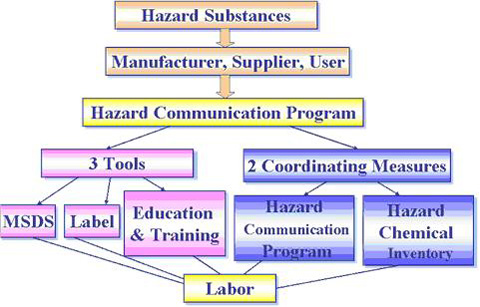Workplace
Council of Labor Affairs (CLA) is responsible for enforcing the Rules of Hazard Communication on
Dangerous and Harmful Materials (RHCDHM) which stipulates Hazcom requirements in workplace.
Currently, CNS 6864 Labels for Dangerous Materials based on 10th edition of UN Recommendation of
Transport of Dangerous Goods (UNTDG, the Orange Book) is adopted by the Rules for chemical
labelling in workplace. CLA is responsible for amending the Rules to adopt GHS and proposes a
new National Standard of chemical classification and labelling based on GHS.
Environmental Agents and Pesticide
In Taiwan, Environmental Protection Administration (EPA) and Council of Agriculture (COA) are
responsible for regulating environmental agents and pesticides, respectively. The first version
of the GHS document (also was called the "Purple Book"), was adopted in December 2002 by the
United Nation (UN) Sub-Committee on the Globally Harmonized System of Classification and
Labelling of Chemicals (UNSCEGHS), and endorsed by the UN Sub-Committee on the Transport of
Dangerous Goods and the Globally Harmonized System of Classification and Labelling of Chemicals
(UNSCETDG).
Transport
Ministry of Transportation and Communication (MOTC) is responsible for enforcing the Traffic
Safety Rule Article 84. Currently, CNS 6864 Labels of Dangerous Materials is adopted in
transport domain, as well as in environmental agents, pesticides, and workplace. In the future,
CNS 6864 will be revised to adopt the 14th edition of UN Recommendation on the Transport of
Dangerous Goods (UNTDG, the Orange Book), in which the classification and labelling have been
harmonized with GHS in a large degree. This revised national standard will be adopted by the
Traffic Safety Rule executively for regulating the Hazcom requirements in transport sector.
Consumers
Ministry of Economic Affairs (MOEA) is the competent authority for the safety of consumer
products in Taiwan.
Emergency Response
Environmental Protection Administration (EPA) in accordance with National Fire Agency (NFA) is
responsible for emergency response of chemical accidents in Taiwan.
Picture Description of Taiwan Hazard Communication Structure
The purpose of the Hazard Communication implementation is to protect labors in the workplace for
their heath and safety. Chemical manufactures and spulliers need to make Hazard Commuication
Program. The program compose of two parts. One part of program is Three Tools and another one is
Two Measures. Three tools are label, MSDS and education or training. Two measures are hazard
communication program and hazard chemical inventory.
